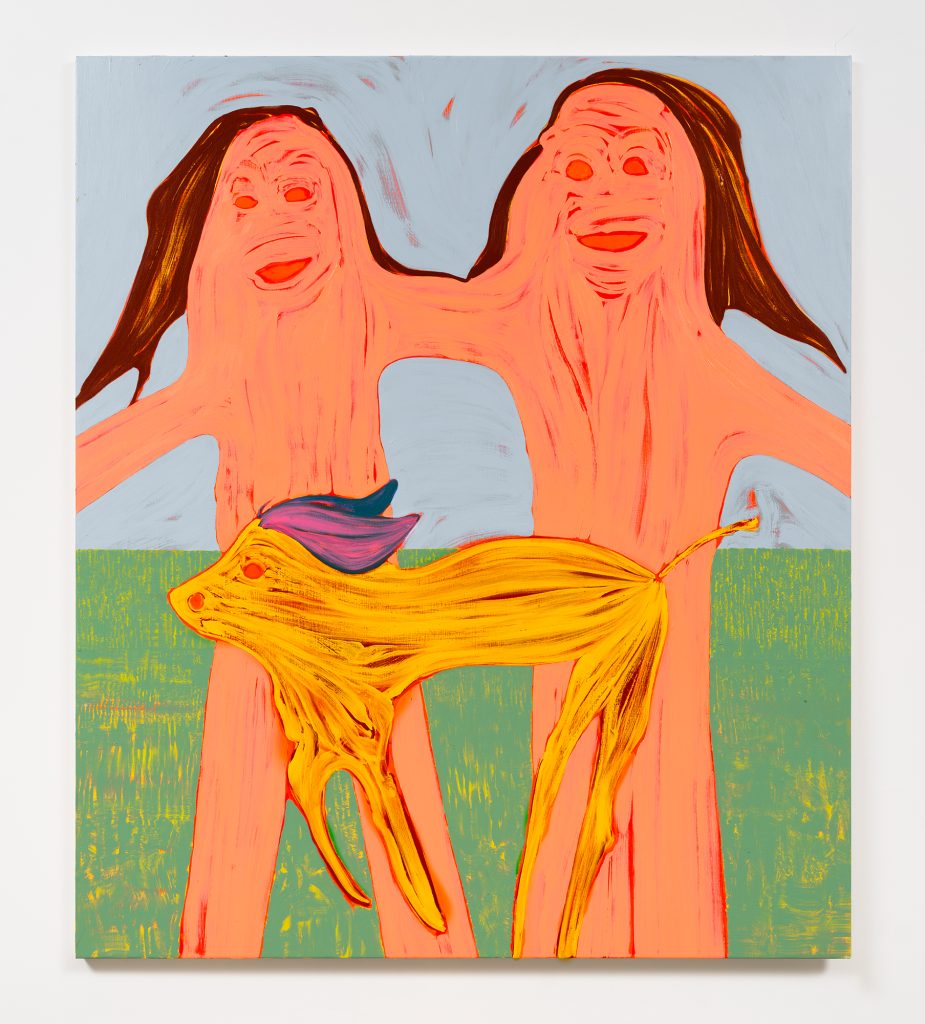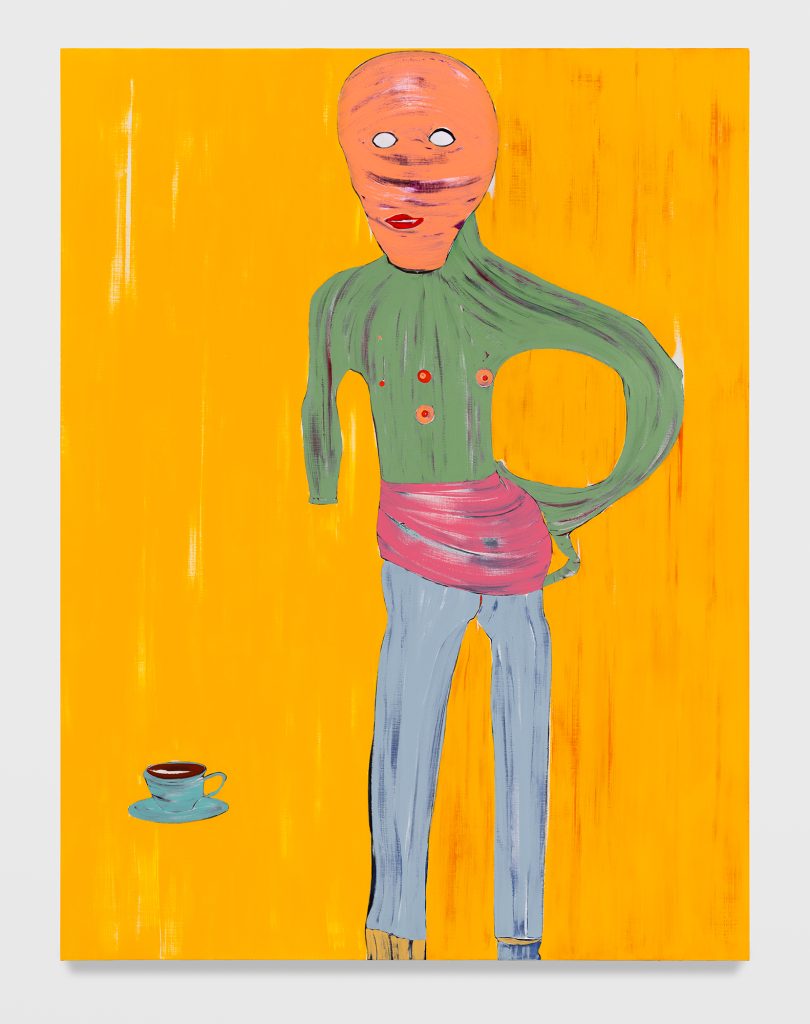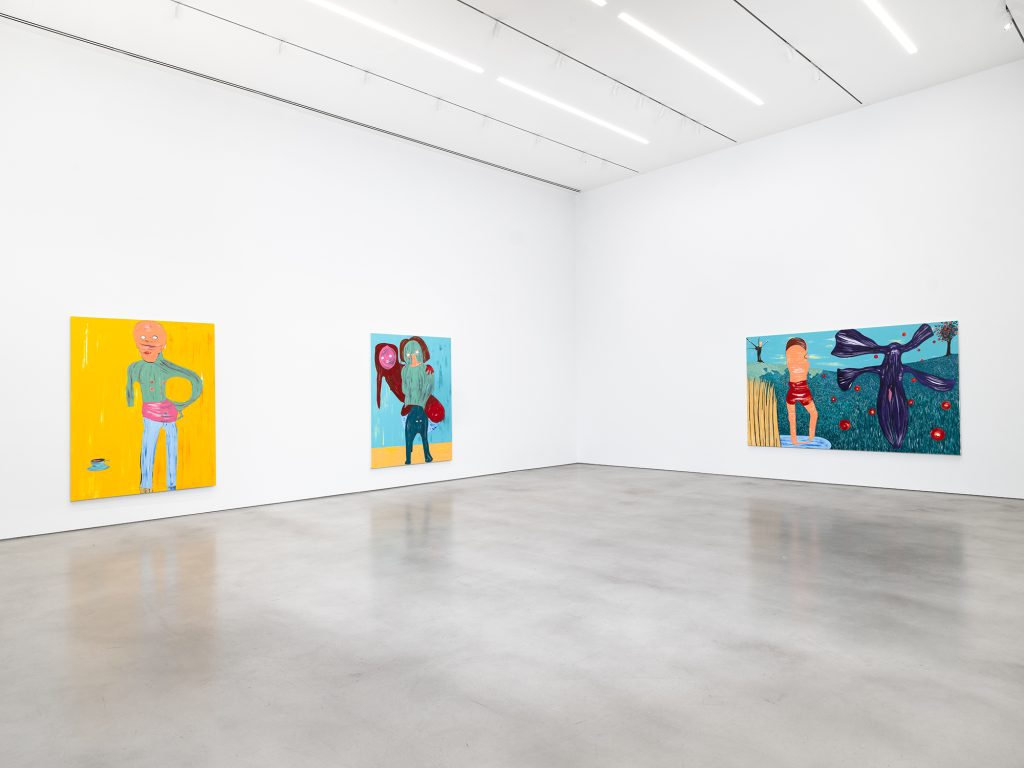Nicola Tyson’s paintings in a recent exhibition at Petzel in New York are confident.
There’s a figure of some kind in every one of the artworks, but none of them are realistically representational. The scenery is instead flat, and the figures breezing by in these aesthetic moments are constructed more from a cascading flow of creative energy across each surface than the rigidity and structure of real-world form. The human figures we see are very much present and, without fail, lively, but much of the time, we don’t know who they are. (One art piece identified as a self-portrait is an exception.)
But there’s no sense of tension in that lack of recognition. There’s not even a real feeling of subtraction from each billowing connection growing between the comprehensible figure present on the canvas and the visitor and viewer. They’re still reaching wistfully, in each instance: a self-sustaining and self-recreating ecosystem in which creative forces dance energetically… landing tantalizingly just out of reach.
There’s not really the sense that these figures are in existential turmoil, either — that the farthest reaches of their materializing presence are undergoing substantial change or on the precipice of becoming someone or something else. Instead, they appear truly secure in their rebuttal of familiar, aesthetic archetypes. These figures look content, happy, and connected.
Their consistent state is one of recreation in which the fuel is drawn from within, amid which color and form merge into each other in a relational reckoning during which the dream, goal, and a place of security are already in view in the middle of all the flux. The flux and lack of precise clarity felt from these forms doesn’t contrast with what in each instance is an overarching feeling of aesthetic and emotional unity. Instead, it’s all persisting together, the first feeding into the next. Steeping in the flux becomes what it means to achieve the kind of aesthetic security and regeneration towards which these relatively visually stable paintings point, as they look holistic and encompassing, even if the forces they’re reflecting can be fleeting and quick.
We see not a precise place, but we see a wave of sensed security nonetheless. And in each painting’s sense of place — which it does establish, even if we don’t actually know what precisely that place actually is — you get the sense that the spatial rearranging responsible for it is also a well from which you can draw a refreshed personhood. That kind of updating self-identity is pulled from not just a relational reckoning but an existential one in which you put your entire sense of placement somewhere else. Your foundational frames of reference, the metaphorical walls that you might ordinarily take for granted…. suddenly you’re looking at them and realizing they’re completely and entirely different from what you remembered and expected. And what’s to be done about that other than turn back to the front and dance?
Place and personhood become what you make of them, and these paintings feel like the contentment of watching those forces unfold.
All of these contemplations mirror how Tyson drew from queer experience in assembling this art. In one example, it’s fairly on the nose; a painting bearing the exhibition’s title (“I am a teapot”) shows a figure doing the “Teapot Tip,” a dance move. It “came to Tyson from a camp parody of the song and dance she learned as a teenager in the queer underground of 1970s London,” Petzel says in a press release, referencing the similarly titled nursery rhyme.
She imbues her painted figures with a field of internal life and self-determination that you feel very sure is going to stay. There’s an abiding independence, which stretches back out from each figure into their inhabited environment.
You might imagine that each of these created, painted characters carries that kind of creator energy with them and refreshes each new space they enter, the created framework of space around them an extension of their self and their experience of it. Everywhere becomes new by virtue of this presence. And you really, honestly keep the sense that all of this is going to keep going. The people and their places will keep going. Their dreams and ambitions, which here feel embodied within their materialized forms, will keep going, even as the particularities of those tangible, lived forms begin to fade away… if they were ever there.
The paintings land like a persistence that is not a fight so much as it is a continuation, an insistence: a voice that becomes a wave.
You can read more about the exhibition, which, again, is already closed, on Petzel’s website at this link.


Featured image: Installation view, Nicola Tyson, I am a teapot, Petzel, 2025. Photos by Jason Mandella. Courtesy of the artist and Petzel, New York.
You may also like
-
Diana Kurz at Lincoln Glenn in New York: A Review of a Shining Art Exhibition
-
Dustin Hodges at 15 Orient in New York City: An Ensnaring Exhibition at an Exciting Gallery
-
Maren Hassinger at Susan Inglett Gallery in New York: Reviewing an Uplifting Art Exhibition
-
Enzo Shalom at Bortolami in New York City: Reviewing an Entrancing Exhibition of Paintings
-
“Ben Werther: Townworld” at Amanita in New York City: Reviewing a Richly Memorable Art Exhibition
